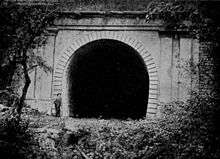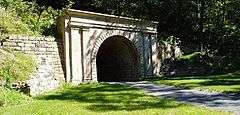Staple Bend Tunnel
|
Staple Bend Tunnel | |
|
Staple Bend Tunnel | |
  | |
| Location | Conemaugh Township, Cambria County, Pennsylvania |
|---|---|
| Coordinates | 40°21′33″N 78°51′19″W / 40.35917°N 78.85528°WCoordinates: 40°21′33″N 78°51′19″W / 40.35917°N 78.85528°W |
| Built | 1833 |
| Architect | Welch, Sylvester; Appleton, J. & E., Builders |
| Architectural style | Other |
| MPS | Allegheny Portage Railroad MPS |
| NRHP Reference # | 94001187[1] |
| Significant dates | |
| Added to NRHP | April 19, 1994 |
| Designated NHL | April 19, 1994[2] |
| Designated PHMC | August 19, 1947[3] |
The Staple Bend Tunnel, about 4 miles (6.4 km) east of Johnstown, Pennsylvania, in a town called Mineral Point, was constructed between 1831 and 1834 for the Allegheny Portage Railroad. Construction began on April 12, 1831.[4] This tunnel, at 901 feet (275 m) in length, was the first railway tunnel constructed in the United States. It is rock bored and stone lined.
Finished in June 1833, the Staple Bend tunnel was advertised as the first railroad tunnel in the United States. It was the third tunnel of any kind built in the US, the first tunnels were for other canals in Pennsylvania.
History
Work began on November 21, 1831 and often occurred during inclement conditions. The men were paid $13 per month plus room and board for 12-hour days 6 days per week. Workers chipped and blasted 901 feet of solid rock to make the tunnel.[5]
Approximately 14,900 cubic yards of bedrock was removed using black powder blasting. This was done by drilling three-foot-long holes and packing them with powder. Drilling one typical hole took up to three hours of hard effort using a three-man crew. Nine to ten holes, each one-inch in diameter and thirty-six inches in length, were made before blasting. One pound of explosive powder wrapped in paper was pushed into each hole, tamped down, punctured with a sharp needle, and a fuse added. Fuses were lit with explosions to occur at mealtime. Workers would eat while the dust settled; then get to work cleaning (mucking) the tunnel. Of the 36-inch hole drilled only 18 inches, or half of the hole, was blasted.[5]
The tunnel grew about 18 inches each day, with both sides moving toward the center. On December 21, 1832 the workmen broke through the final barrier and connected the two ends of the tunnel. There was much celebration with speeches and toasts. The full tunnel excavation was completed in April 1833.[5]
The ends of the Staple Bend Tunnel were lined with cut stone for safety. Rock and dirt might fall due to rain or other weather, or from the effects of the portage railroad going through the tunnel. The fancy entranceways to the tunnel were to impress the travelers and the general public. The style was described as a " Roman Revival style with low relief lintel supported by Doric pilasters on each side." Of the money spent (the total cost was $37,498.85) nearly half was to build the fancy entrance ways. Although it is believed no workers was killed during the construction of the Tunnel, a prominent Cambria County citizen by the name of Rowland Humphreys was killed in the Tunnel on/about June 12, 1852 as he was walking next to a train and was crushed to death by shifting cargo from one of the cars.[6] A few years later, the Portage RR and Tunnel was sold to the Pennsylvania Railroad in 1857.[5]
After the Portage

In 1907, Henry Storey wrote that the east entrance facade of the tunnel had been removed for building purposes. He gave no indication of a date or the building on which the stones were used. The west entrance facade remains and has been restored to its former grandeur.[5]
After the demise of the old Portage Railroad the tunnel had other uses. Neither the "new Portage" nor the Pennsylvania Railroad used the tunnel. It was instead a popular carriage route until the Flood of 1889. Afterward, Flood damage and other concerns made the tunnel a less desirable driving spot although local residents continued to visit, and even go courting at the tunnel up until the 1940s.[5]
In the 1940s a concrete liner was added to the east portal of the tunnel and large water lines as well as a water vault structure were built. The Manufacturer's Water Company closed the tunnel to the public, the water lines were used by Bethlehem Steel. In 2001 the tunnel became part of Allegheny Portage Railroad National Historic Site. Rock bolts, shoring posts, and other reinforcements were added as well as a thin mortar between the historic blocks.[5]
It was designated a National Historic Landmark in 1994,[2] and is now part of the Allegheny Portage Railroad National Historic Site, administered by the National Park Service.[5]
See also
References
- ↑ National Park Service (2007-01-23). "National Register Information System". National Register of Historic Places. National Park Service.
- 1 2 "Staple Bend Tunnel". National Historic Landmark summary listing. National Park Service. Retrieved 2009-02-04.
- ↑ "PHMC Historical Markers". Historical Marker Database. Pennsylvania Historical & Museum Commission. Retrieved December 19, 2013.
- ↑ Rivanna Chapter, National Railway Historical Society (2005). "This Month in Railroad History: April". Retrieved April 12, 2006.
- 1 2 3 4 5 6 7 8 "Staple Bend Tunnel". National Park Service. Retrieved 21 December 2014.
- ↑ Book: Two Generations on the Allegheny Portage RR, by Chris J. Lewie, Burd Street Press, White Mane Books, 2001
- This article incorporates public domain text created by the US government. See: http://www.nps.gov/alpo/historyculture/staplebend.htm
External links
| Wikimedia Commons has media related to Staple Bend Tunnel. |
- Historic American Buildings Survey (HABS) No. PA-1233, "Allegheny Portage Railroad, Staple Bend Tunnel"
- Historic American Engineering Record (HAER) No. PA-240, "Allegheny Portage Railroad, Staple Bend Tunnel"
- National Park Service website for Staple Bend Tunnel
- Cambria County listings at National Register of Historic Places
- Staple Bend Tunnel restoration


